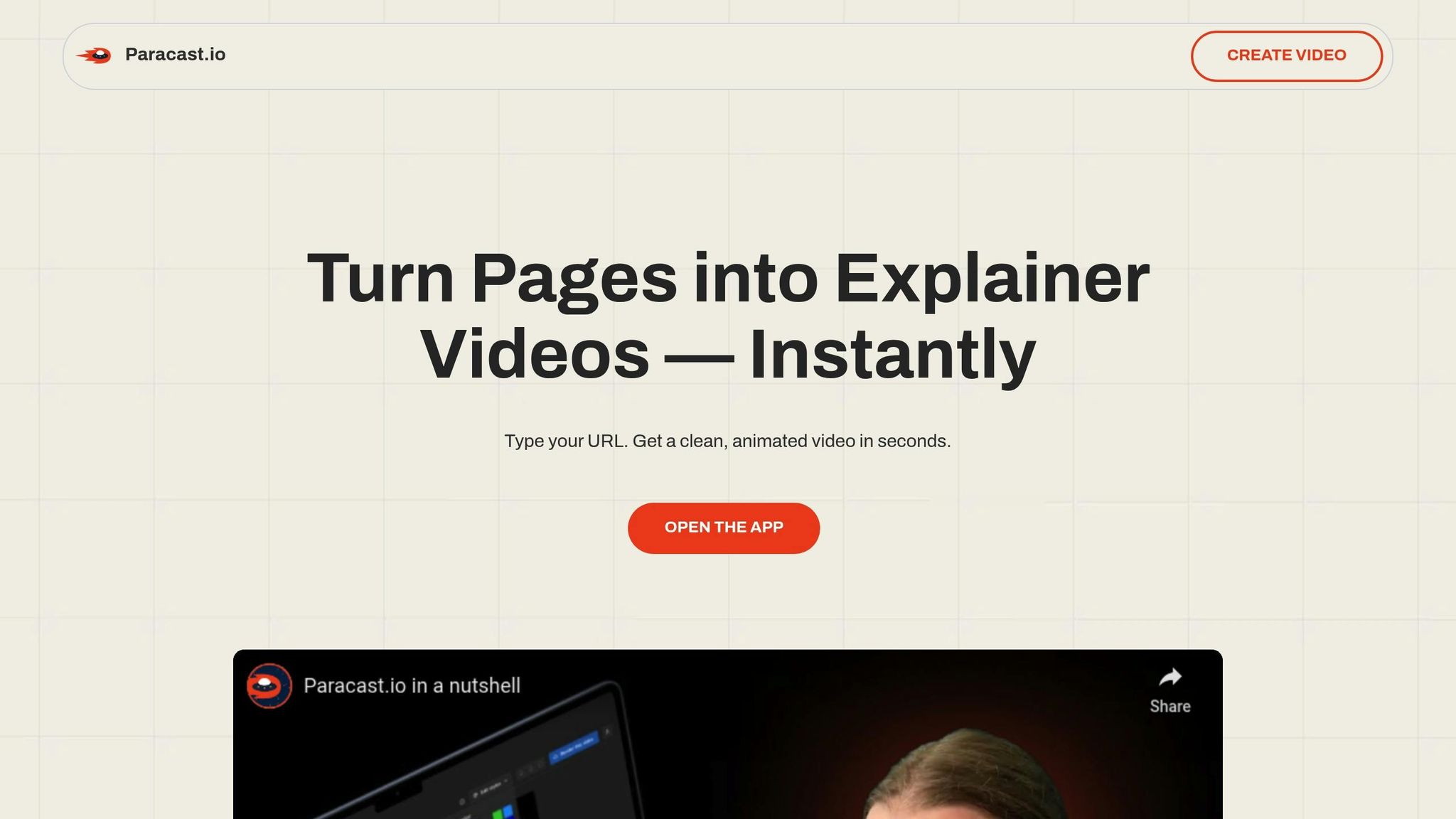Personalized videos can boost revenue by 40% and increase customer engagement by 74%. Real-time data sync makes this possible by instantly tailoring video content to each viewer’s preferences. Here's how it works:
- What It Does: Syncs data in real-time to adjust video elements like text, scenes, and calls-to-action.
- Why It Matters: Personalized videos drive higher conversions, with ROI reaching up to $20 for every $1 spent.
- Who Benefits: Startups, agencies, freelancers, and small teams can use this for product demos, campaigns, or training materials.
- Key Technologies: APIs, webhooks, and event systems ensure seamless data updates within milliseconds.
Platforms like Paracast.io make it easy to create and deliver personalized videos with features like AI-powered templates, real-time rendering, and cloud processing. Personalization isn’t optional anymore - 80% of consumers expect it. Let’s explore how to implement this effectively.
Unlocking Real Time Personalization Through Data, AI, and Communication
Data Sync System Components
Real-time data synchronization plays a key role in creating personalized video experiences by seamlessly connecting various components. These systems make it possible to deliver dynamic, tailored content almost instantly.
Core Data Flow Elements
Three main components work together to ensure instant data transmission:
| Component | Primary Function | Example in Action |
|---|---|---|
| APIs | Facilitate standardized data exchange | Integrate CRM data into video content |
| Webhooks | Trigger immediate actions | React to events like cart abandonment |
| Event Systems | Handle real-time updates | Adjust viewer preferences on the fly |
These elements work in harmony to enable seamless data transfer. For instance, when customer data is pulled from Snowflake, the system can immediately access and use the information to create personalized video content - no batch processing required. Up next, we’ll explore the performance benchmarks needed to ensure these components work efficiently for dynamic video updates.
Speed Requirements for Video Updates
To deliver a smooth and timely experience, specific response times are crucial:
- Under 200 milliseconds: For interactions that feel instantaneous.
- 500–1,000 milliseconds: Ideal for personalizing website-based content.
- 1–2 seconds: Necessary for more complex customizations involving multiple data points.
To achieve these speeds, companies rely on technologies like distributed processing and edge computing, which bring content delivery closer to the end user.
Common Data Sync Issues
Even the best real-time systems can encounter challenges. Here are a few common issues and how they’re managed:
- Data Inconsistency: Validation and reconciliation processes are used to maintain data accuracy.
- Timing Conflicts: Version control ensures only the most up-to-date data is utilized.
- Scaling Difficulties: Cloud infrastructure with auto-scaling and content delivery networks helps manage growing demands.
To stay ahead of potential disruptions, companies use tracking tools to monitor and resolve issues before they affect the viewer’s experience. A structured approach based on the 4Ds - Data, Decisioning, Design, and Distribution - provides a solid foundation for successful implementation.
Video Personalization Platforms
Today’s platforms are all about creating tailored, data-driven video experiences. With 91% of consumers more likely to engage with personalized content, these tools have become a cornerstone for delivering dynamic and engaging video interactions. Below, we’ll explore how these platforms use core data sync features to make video personalization seamless and effective.
Paracast.io Platform Overview

Paracast.io stands out as an AI-powered platform designed for real-time video personalization. Built on a cloud-based architecture, it ensures smooth and consistent performance while integrating personalized elements into videos.
Here’s a breakdown of its key features:
| Feature | Function | Benefit |
|---|---|---|
| AI-Powered Generation | Creates content from website URLs | Speeds up the creation process |
| Template System | Offers pre-designed layouts | Maintains brand consistency |
| Real-time Rendering | Updates dynamic content instantly | Keeps content relevant |
| Cloud Processing | Leverages distributed computing | Handles high-volume demands |
These features work together to support real-time data synchronization, enabling highly customized video experiences.
Key Data Sync Functions
To meet the demand for fast and responsive updates, Paracast.io incorporates several critical data sync functions. These ensure that personalized videos not only look great but also perform well:
-
Schema Detection and Validation
Incoming data formats are validated in real time, reducing errors and ensuring smooth processing. -
Dynamic Template Management
Templates are updated instantly without sacrificing quality. This is a game-changer, given that personalized videos see a 150% higher click-through rate compared to generic content. -
Cloud Architecture Integration
The platform’s cloud-based system processes multiple data streams simultaneously and scales effortlessly to meet demand.
"Personalized videos perform better than generic videos in 1:1 marketing" - Pirsonal
As consumer expectations evolve, platforms like Paracast.io continue to lead the way. In fact, 80% of consumers now view personalized experiences as essential when making purchasing decisions. These tools are no longer optional - they’re a must-have for staying relevant in today’s market.
sbb-itb-5bfa442
Data Sync Implementation Guide
Data Source Setup
To ensure smooth integration, establish dependable connections between your data feeds and video templates. Here's a breakdown of common connection types and their purposes:
| Connection Type | Purpose | Key Requirements |
|---|---|---|
| API Integration | Real-time data updates | Authentication tokens, rate limiting |
| Database Sync | Access to historical data | Connection pooling, query optimization |
| Webhook Events | Trigger-based updates | Event validation, retry logic |
Design templates that can handle various data formats. This flexibility helps your system adapt to changing data needs without significant overhauls.
- Implement automated backup systems to safeguard against data loss.
- Set up data validation rules to ensure consistency and reliability.
Once your data sources are configured, prioritize securing the information to uphold trust and maintain system performance.
Data Protection Standards
Protecting your data is essential. Follow these key standards to ensure security:
-
Encryption Implementation
- Use TLS 1.3 for secure data transmission.
- Apply AES-256 encryption for stored data.
- Implement end-to-end encryption for especially sensitive information.
-
Compliance Framework
- Adhere to GDPR for handling data from the EU.
- Follow CCPA regulations for California residents.
- Address any additional industry-specific compliance requirements.
-
API Security
- Enforce strict protocols, including:
- Rate limiting to prevent misuse.
- Token-based authentication for secure access.
- IP whitelisting to restrict access to trusted sources.
- Enforce strict protocols, including:
Performance Tracking
Keep a close eye on your sync performance by monitoring critical metrics:
| Metric | Consideration | Monitoring Frequency |
|---|---|---|
| Sync Latency | Minimize update delays | Real-time |
| Data Accuracy | Ensure high consistency levels | Regular intervals |
| System Uptime | Strive for continuous availability | Continuous |
| Error Rate | Reduce errors to the lowest possible level | Periodic reviews |
For large datasets, use distributed caching, smart retry mechanisms, and queue-based processing to optimize performance. Proactively monitor system resources to address potential issues before they disrupt operations.
Conclusion: Next Steps
Real-time data synchronization isn’t just a tech buzzword - it’s a game-changer for video marketing. Personalized videos have been shown to drive six times higher transaction rates and hold 78% of viewers' attention within the first 20 seconds of playback. That’s a significant boost in both engagement and conversions.
Key Takeaways
Integrating real-time data sync into your video strategy can transform how brands engage with their audience. Here’s a snapshot of the potential benefits:
| Benefit | Impact | Metric |
|---|---|---|
| Better Conversions | 202% increase | Personalized CTAs vs. generic |
| Increased Sharing | 50% higher rates | Videos in email campaigns |
| Higher Engagement | 78% retention rate | First 20 seconds of viewing |
These figures underscore the importance of having a unified data environment. By implementing a customer data platform (CDP), you can consolidate data from various sources, ensuring every video delivers consistent and accurate personalization while adhering to data protection standards.
If you’re ready to take your video content to the next level, consider using Paracast.io. Its AI-powered tools, pre-designed templates, and intuitive editing interface make creating personalized, high-quality videos (in 1080p resolution) a breeze. Combine Paracast.io with edge computing to minimize latency and deliver seamless viewing experiences.
FAQs
How does real-time data syncing make personalized videos more effective?
Real-time data syncing keeps personalized videos current with the latest information, ensuring they resonate more with viewers. By dynamically integrating recent actions, preferences, or events, these videos provide messaging that feels timely and directly relevant.
This kind of personalization does more than just grab attention - it drives higher engagement and improves conversion rates. Whether it's highlighting product recommendations, celebrating milestones, or unveiling new features, real-time updates strengthen the connection with your audience.
What technologies make real-time data updates possible for personalized videos?
Real-time data updates for personalized videos hinge on a blend of advanced technologies. At the core are machine learning algorithms and data analytics, which process and interpret live data inputs. These tools analyze user behavior and preferences as they happen, enabling videos to adapt dynamically to individual needs.
On top of that, data streaming platforms ensure a seamless flow of information, allowing video content to refresh instantly whenever new data comes in. Together, these technologies work in harmony to create personalized videos that feel interactive and tailored, all thanks to real-time data synchronization.
What challenges do companies face with real-time data syncing for personalized videos, and how can they address them?
When companies dive into real-time data synchronization for personalized videos, they often face a few key hurdles. Data silos can block smooth integration, inconsistent or low-quality data can hurt personalization efforts, and managing large amounts of data in real time can be overwhelming.
To overcome these obstacles, businesses should prioritize a few critical steps. First, adopting integrated data management systems can help eliminate silos and improve data flow. Second, setting up routine data validation processes ensures the information used is accurate and reliable. Lastly, investing in scalable infrastructure allows businesses to handle heavy data loads without a hitch. Together, these strategies help keep personalized video content precise, timely, and effective.


